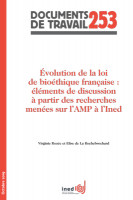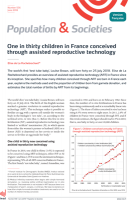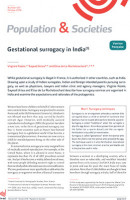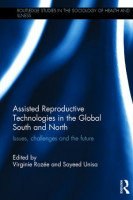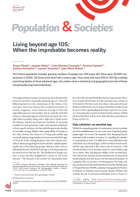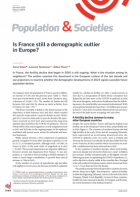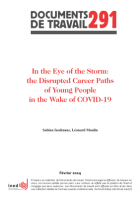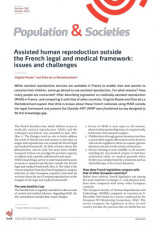
Assisted human reproduction outside the French legal and medical framework: issues and challenges
Population and Societies
n° 593, October 2021
https://doi.org/10.3917/popsoc.593.0001
The French bioethics law was amended in 2021 to take account of medical and societal advances, notably regarding medically assisted reproduction (MAR). One of its aims is to limit use of MAR outside the legal and medical framework. French legislation nonetheless remains restrictive compared with other European countries, so the practice is liable to continue. To shed light on the current situation and anticipate future developments, INED is launching the Outside-ART survey to study the diverse range of assisted reproductive experiences and practices.
Medically assisted procreation, MAR; in vitro fertilization, IVF; gamete donation; oocyte donation; cross-border reproductive care, CBRC; bioethics law; France; Europe
Table of contents
- Appendix A References
1.
While assisted reproductive services are available in France to enable men and women to conceive their children, some go abroad to use assisted reproduction. For what reasons? How many people are concerned? After describing legislation on medically assisted reproduction (MAR) in France, and comparing it with that of other countries, Virginie Rozée and Elise de La Rochebrochard explain that little is known about these French nationals using MAR outside the legal framework and present the Outside-ART (AMP sans frontières) survey designed to fill this knowledge gap.
The French bioethics law, which defines access to medically assisted reproduction (MAR) and the techniques permitted, was amended in June 2021 (Box 1). The changes voted on aim to better address the needs of French men and women so that they no longer seek reproductive care outside the French legal and medical framework. Yet little is known about this phenomenon, and its scale has never been reliably measured. So how can we judge the new law’s capacity to address such a poorly understood social issue?
1.1. Box 1. Definition of medically assisted reproduction (MAR)
MAR includes:
• ovulation induction, controlled ovarian stimulation, ovulation triggering (not explored in the survey)
• artificial insemination (AI): sperm from the partner or a donor (a procedure known as donor sperm insemination) is injected into the woman’s reproductive tract.
• in vitro fertilization (IVF): fertilization takes place in a test tube with gametes taken from the parent(s) or one or more donors (egg donation, sperm donation, double gamete donation, embryo donation).
• All other existing techniques are variants of AI and IVF or derived from them. They include surrogacy and pre-implantation genetic diagnosis, which is used to detect genetic or chromosomal alterations in the embryo just after fertilization. Oocyte freezing (or vitrification) is a method of preserving women’s oocytes so that they can use them for in vitro fertilization later.
• Here, we also use the term assisted reproduction to cover the full range of practices not requiring medical assistance (such as ‘at home’ insemination, which health professionals do not perform).
INED is launching a survey to understand and measure recourse to assisted reproduction outside the French legal and medical framework (Box 2). But what is the current situation? How does French legislation compare with that of other European countries? And what do we know about the use of assisted reproduction on the margins of the legal and medical framework?
1.1. Box 2. Who can take part in the Outside-ART survey? And how?
![]()
Outside-ART survey advertisement, detailing the survey’s objectives, who can participate, access to the online questionnaire (in French), and data protection regulations.
1.1. The new bioethics law
The bioethics law is regularly amended to take account of societal and medical advances. Regarding MAR, the 2021 amendment includes three major changes:
1. Access to MAR is now open to all women, whatever their partnership status (it was previously restricted to heterosexual couples).
2. Children born through gamete donation now have access to their origins: information on the donor(s) will now be supplied to them on request (gamete donation was previously strictly anonymous).
3. Oocyte freezing is now available to all women, including for non-medical reasons (it had been authorized solely on medical grounds when fertility was compromised by a treatment such as chemotherapy, or for oocyte donation).
1.2. How does French legislation compare with that of other European countries?
Before these reforms, French legislation was among the most restrictive in Europe [1], and advances have been slow compared with many other European countries.
The European Society of Human Reproduction and Embryology (ESHRE) compared 43 countries on 31 December 2018 based on a survey conducted by the European IVF-Monitoring Consortium (EIM). The survey compares the legislation in force in each country, but also the practices that are lawful but not covered by specific legal provisions. Here, we cover 41 countries (Table 1), excluding those where gamete donation for heterosexual couples is prohibited (Turkey and Bosnia–Herzegovina).

As of 2018, sperm donation is allowed for single women and/or female couples in three-quarters of these countries: for single women in 30 countries and for female couples in 18 countries. Likewise, non-medical oocyte freezing is already available in three-quarters of countries. For gamete donation, two-thirds of countries operate a system where donation is not totally anonymous. Donation is totally non-anonymous in two of the 41 countries, 13 operate a mixed anonymous/non-anonymous system, and seven others provide donor information to the children only (and not the parents). In five countries, disclosure of the donor’s identity is possible only if the child has a severe health condition.
This brief comparison shows that before the 2021 amendment, legislation in France was more restrictive than in many other European countries. This disparity in MAR practices between France and its neighbours has led to a phenomenon of transnational use, whereby French residents cross borders to use MAR.
1.3. What is the scale of cross-border reproductive care? Uncertain estimates
Cross-border reproductive care (CBRC) is a worldwide phenomenon. To access MAR treatments or techniques, people may travel, for example, from the United Kingdom to Spain or the Czech Republic; from Canada to the United States or Mexico; from Australia to Southeast Asia. France has among the highest levels of CBRC in Europe, as two studies on this issue have revealed [2, 3].
In the first, ESHRE measured levels of demand in 2008–2009 in six European countries receiving patients for CBRC: Belgium, Czech Republic, Denmark, Slovenia, Spain, and Switzerland [2]. Only 46 centres for reproductive medicine took part, representing 17% of all facilities operating in these six countries. Based on the activity observed over 1 month, ESHRE estimated that between 12,000 and 15,000 CBRC patients were received annually by these centres at that time. But given that less than 20% of all centres took part in the study, the total could be more than 5 times higher (more precisely 5.7 times higher). And this total omits the CBRC provided in European countries not included in the study, such as Greece.1 However, as little is known about CBRC, ESHRE remained prudent in its estimate, indicating that the number should be doubled ‘at least’. The authors thus obtained a minimum of between 11,000 and 14,000 CBRC patients each year in these six countries. Applying a multiplier of 5.7, this gives an annual total of between 31,000 and 40,000 patients. These totals that range between 11,000 and 40,000 patients per year reflect the uncertainty of the estimates. Most of these CBRC patients came from four countries: Italy (32%), Germany (14%), the Netherlands (12%), and France (9%). Most French patients (85%) went to Belgium, but this observation was probably linked to the fact that 50% of Belgian centres took part in the study (9 out of 18), while only very few Spanish centres were represented (out of 180 in total in the country).
The second study was conducted in 16 Belgian centres (out of 18) and analysed CBRC over the period 2000–2007 [3]. It showed that most CBRC patients came from the same four countries as those identified in the ESHRE study: France (38%), the Netherlands (29%), Italy (12%), and Germany (10%). Three-quarters (73%) of the patients from France went to Belgium to receive donor sperm, and their numbers were growing rapidly at the time, with an increase from 400 to 600 patients between 2005 and 2007.
Both pioneering studies have major limitations and cannot provide a reliable estimate of the number of CBRC patients. They also date back more than a decade, and patient numbers may have increased substantially since then. Unfortunately, no major statistical study of CBRC has been conducted since 2009, but both studies were concordant in their finding that a large share of these patients were from France.
How has the situation evolved since then, and how might the amendments to the law on bioethics change things in the future?
1.4. Why go abroad for reproductive care?
A qualitative study conducted by INED in 2010–2012 [4] showed that French residents who used CBRC did so to bypass legal and medical restrictions, but also to obtain treatment perceived to be more readily available, more effective, and more personalized. This was notably the case for heterosexual couples legally eligible for MAR in France.
The amended law will ease the legal restrictions that obliged a share of patients to seek treatment abroad. However, it still leaves out some people (such as male couples and transgender individuals) and continues to proscribe some techniques available (authorized or unlegislated) elsewhere in Europe [1]. Surrogacy remains strictly prohibited in France, while it is possible in 15 European countries including Belgium and the Netherlands (Table 1), as is posthumous assisted reproduction, authorized in Belgium, Spain, and the United Kingdom; and in vitro fertilization (IVF) of oocytes donated by a woman for transfer to her female partner (known as intra-partner oocyte donation), possible in Spain and Belgium. MAR is also available without restriction to transgender people in 19 European countries (Table 1).
Beyond these legal reasons, difficulties remain in the provision and organization of MAR, so CBRC is likely to continue in the coming years. The main obstacle to MAR in France appears to be that of gamete donation, oocytes especially, with its long waiting lists.
IVF with oocyte donation is rare in France, representing just 1% of all IVF procedures carried out in the country. By comparison, in 2016, 5% of IVF procedures involved donated oocytes in the United Kingdom and 6% in Italy (where it has been legal since 2014). Given the rarity of oocyte donation and the long waiting lists in France, some patients prefer to shorten their waiting time by travelling abroad.
1.5. The Outside-ART survey to address new challenges in reproductive care
These observations suggest that CBRC will not disappear in France, even after the new bioethics law comes into force. On 1 October 2021, INED launched the Outside-ART survey, funded by the French National Research Agency, to examine the question from a scientific perspective.
All people who have used assisted reproduction outside the French legal and medical framework, or plan to do so, are invited to complete an online questionnaire that asks for details of their trajectory and experience (https://amp-sans-frontieres.fr).2 Our survey will shed light on the numbers of people who turn to MAR outside the French medical and legal framework, and on their reproductive trajectories. These issues will be analysed from a broad perspective, considering not only CBRC but also all procedures performed in France without medical assistance and about which little is known (such as underground surrogacy with women offering to be surrogates on the Internet, or ‘at home’ insemination with sperm imported from abroad, for example).
Appendix A References
-
[1] Calhaz-Jorge C. et al., 2020, Survey on ART and IUI: legislation, regulation, funding and registries in European countries, Human Reproduction Open, 2020(1), 1–15.
-
[2] Shenfield F. et al., 2010, Cross border reproductive care in six European countries, Human Reproduction, 25(6), 1361–1368.
-
[3] Pennings G. et al., 2009, Cross-border reproductive care in Belgium, Human Reproduction, 24(12), 3108–3118.
-
[4] Rozée Gomez V., de La Rochbrochard E., 2013, Cross-border reproductive care among French patients: Experiences in Greece, Spain and Belgium, Human Reproduction, 28(11), 3103–3110.
Greece is known to practise CBRC, with oocyte donations especially. Its absence from the ESHRE study may be due to the difficulty of obtaining information about Greek centres for reproductive medicine, since just four of its 50 centres submitted data for the general report on European ART in 2009.
There were two methodological options: either to contact patients via foreign clinics (the approach used in previous studies, with the limitations we have described) or to apply a previously untried method that involved contacting the relevant individuals directly via the network of French associations and social media that support people seeking reproductive care outside the legal and medical framework. After studying methodological aspects with specialists from INED’s Surveys and Statistical Methods Departments (results available in an open access working paper: https://www.ined.fr/fr/publications/editions/document-travail/quelles-methodes-pour-estimer-taille-population-difficile-a-enqueter/), the second option was chosen. Specific statistical methods are needed to analyse samples recruited without a sampling frame. In our case, the benchmark-multiplier method will be applied.
The French bioethics law was amended in 2021 to take account of medical and societal advances, notably regarding medically assisted reproduction (MAR). One of its aims is to limit use of MAR outside the legal and medical framework. French legislation nonetheless remains restrictive compared with other European countries, so the practice is liable to continue. To shed light on the current situation and anticipate future developments, INED is launching the Outside-ART survey to study the diverse range of assisted reproductive experiences and practices.
Cite the article
Virginie Rozée, Elise de La Rochebrochard, « Assisted human reproduction outside the French legal and medical framework: issues and challenges »,
Population & Societies, 2021, 593, October, p.1-4.
 This document may be reproduced free of charge on paper or online using our Creative Commons licence.
This document may be reproduced free of charge on paper or online using our Creative Commons licence.

